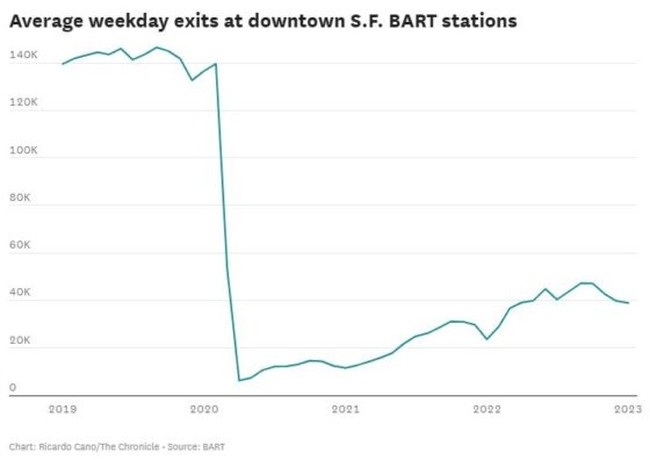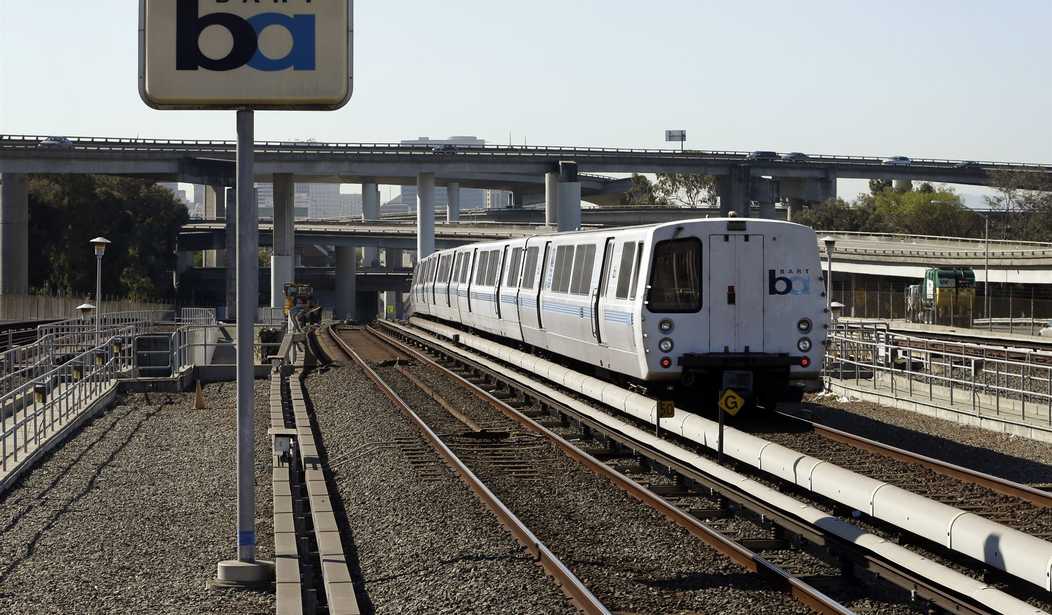We’ve recently covered the latest evidence that San Francisco’s commercial real estate space is in deep trouble. Specifically, the owner of two of the city’s largest hotels is walking away from the properties in a sign that they don’t believe the city is going to recover soon enough to make them profitable.
But the doom loop isn’t just about the decline in office occupancy and the consequent decline in shopping downtown. The real moment when the doom loop becomes inevitable is when the public transport that supports travel to and from downtown areas collapses from a lack of ridership. This is something that San Francisco was struggling with even before the pandemic. This story is from February 2020:
Though trains continue to fill during rush hour, fewer people are riding BART to museums, parks or shopping centers.
Outside the peak commute times, ridership plummeted — from 62.2 million in 2015 to 52.7 million last year.
At the time, there seemed to be a limit to how far ridership could continue to fall because five days a week people still needed to get to work. But the pandemic changed that, probably permanently. Here’s a chart showing what happened to Bart ridership over the past three years.

You can see there has been some recovery but not nearly enough to fund the operations of BART as it currently exists. And that leaves some unpleasant choices.
In its worst-case scenario, BART would impose mass layoffs, close on weekends, shutter two of its five lines and nine of its 50 stations and run trains as infrequently as once per hour. Those deep cuts, agency officials say, could lead to the demise of BART.
Once you start cutting back on service, riding BART becomes even less appealing and ridership probably continues to decline. That could be a death spiral for BART but it’s also a key part of the doom loop for San Francisco. Yesterday, the SF Chronicle published a opinion piece by an urban planner who spelled out the situation.
Despite what many skeptics and anti-urbanists posit, we are not in a “doom loop” yet. Yes, the impact of the shift to work from home is significant and foot traffic is down. Office vacancies are high. But we’ve bounced back before. The overall trend of return to office and activity in downtowns is upward.
But all this positive movement could come to an end if our largest transit agencies have to slash service in order to balance budgets.
While the pandemic was and still is a major shock to our region’s downtowns, the biggest long-term threat to Bay Area cities and downtowns is the impending transit fiscal cliff. Across the Bay Area’s transit systems, federal relief funds are running out, fares remain a fraction of pre-COVID levels and inflation has pushed costs higher…
Today, 8 in 10 BART trips begin or end in either downtown San Francisco, downtown Oakland or downtown Berkeley. In other words, those three downtowns make BART what it is — and BART enables those downtowns.
Did you catch all that? The difference between a doom loop for the entire Bay Area and some kind of longer term recovery probably comes down to whether or not BART is forced to balance its budget. Right now, the system is headed for a $2 billion deficit over five years. There’s just no way it can cut services substantially enough to bring that back into balance without also causing a lot more riders to abandon the system.
You probably see where all of this is going. If you guessed more state money, you guessed right.
The San Francisco Board of Supervisors unanimously adopted a resolution urging Sacramento to do more to save the city’s transit systems from a looming fiscal cliff with the state budget deadline a little over a week away.
Sponsored principally by Supervisor Matt Dorsey, the resolution urges Gov. Gavin Newsom and the state Legislature to provide funding that is “based on a formula that avoids service cuts that most impact transit-dependent riders.”…
The resolution is the latest move in a monthslong campaign by Bay Area lawmakers to obtain operations funding for the region’s transit agencies in the state budget. Advocates say the funding is critical to avoid a “death spiral” where funding cuts lead to service cuts and deepening loss of fare revenue.
As a former Mayor of San Francisco it’s hard to imagine Newsom is going to let the doom loop happen for lack of funds. So sometime soon the entire state will start subsidizing the Bay Area’s rail system. And if that happens maybe the doom loop will be held at bay a while longer.
But the bottom line here is that, post-pandemic, the cities don’t work the way they used to. With more people working at home for the long run, the entire Bay Area is going to have to find some new equilibrium to make the trip downtown worthwhile.







Join the conversation as a VIP Member